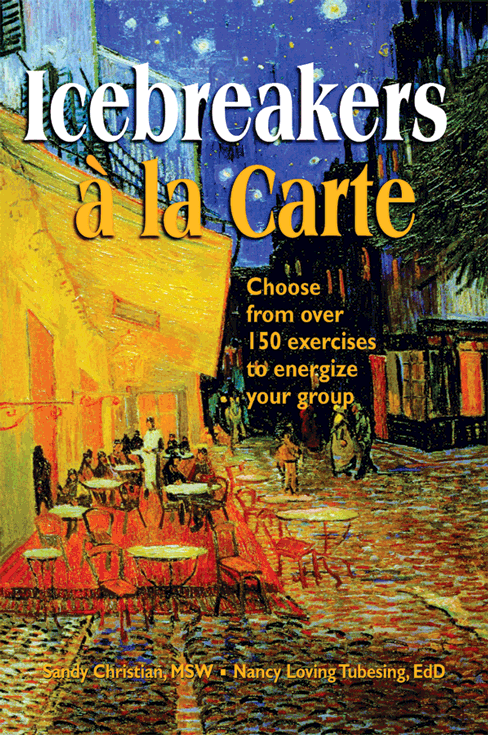Excerpted from Icebreakers a la Carte
By Sandy Christian, MSW and Nancy Loving Tubesing, EdD
All groups need icebreakers. The world is full of shy people who need focus and a very specific way to talk frankly about themselves. Icebreakers provide a vehicle for sharing select personal information, freeing people from constraining anxiety, and guiding participants into authentic, purposeful, often touching conversations.
Icebreakers are not just for getting acquainted. They are especially useful for groups of strangers; but even well-acquainted groups can use icebreakers to ease into a course or group discussion, provide focus for group activities, and establish the proper climate for learning. From first meetings to final farewells, icebreakers pave the way for people to be real.
Icebreakers make the group, and its members, attractive to participants. Not everyone will like everyone else in a group, but the more people are attracted to other participants, and discover common interests, goals, and values, the more eager they will be to participate. Icebreakers induce people to share in spontaneous ways that stimulate lively interaction and draw people to one another.
Icebreakers affirm the rights of participants. Everyone who joins a group has human rights: to be recognized as individual, to have input into some group decisions, to have an equal opportunity to participate in the group, to establish goals and work towards them, to have others respect personal privacy, and to have the group be a safe, secure place in which not one is belittled or degraded. Icebreakers direct participants into activities and behaviors that uphold and affirm these rights in words and actions.
Icebreakers should be relevant to all participants. Everything you do should be relevant to the culture of the group, and its members. Icebreakers as well as other group activities should be presented in the context of participants’ life experience and be relevant in language, values, and style.
Trust is the most important variable to consider when using icebreakers. Icebreakers help establish trust and contribute to its strength throughout the life of the group. The bottom line is, “Can I be honest here and say what I really think and feel?” If the answer is no, the group is constrained from lively, spontaneous communication and deterred in its purpose. Icebreakers remind people, over and over, that open, heart-searching communication is like a wind blowing the group spirit in the right direction.
Icebreakers are vehicles for shaping open group systems. The best environment for learning is an open system, one that accepts and welcomes diverse people, invites honest communication, expresses warmth and affection freely, challenges individuals to grow, shares warmth and affection freely, challenges individuals to grow, shares power and will its members, provides support for people who need it, respects personal boundaries, and honors the limits of the group itself.
Icebreakers provide a way of quickly introducing these values to the group in action and words. Since the rules of the system are often decided in the first few minutes of interaction (without ever talking about them, just by watching each other and the group leader for clues about how to behave), it’s all the more important that icebreakers be used early on to lay the foundation for an open system.
Equal, active participation is an implicit goal of all icebreakers. Successful groups are the responsibility of all participants. The more you inform people about their choices, the more they can take responsibility for group learning. Knowing what the leader has planned, why a particular activity was chosen, and what their roles want responsibilities will be, helps group members make clear decisions about how they want to participate.
Most groups need a balance of activities. Too much of any one thing creates a lop-sided group; overly friendly, chatty groups may never get down to business, while “all work and no play” groups may suffer from boredom. Most groups function beset with a mixture of activities, some light-hearted, others serious.
Experiential, holistic learning is ideal. Learning involves the whole person: mind, body, spirit, relationships, and emotions. When group activities incorporate all these aspects of learning and accommodate the different learning styles of individuals, the chances are great that group members will have a complete experience, one they can integrate with previous experience and apply to everyday life, resulting in a genuine change of attitudes, perceptions, feelings, thoughts, and behaviors.
*For use with your clients: Cartoon Captions, a zippy method of applying humor to challenging situations. Be sure to check out the two variations.

